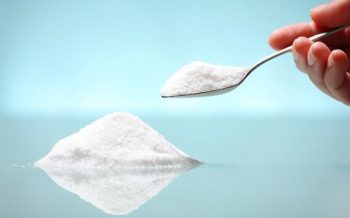Contributing writer for Wake Up World
Sucralose (sold under the brand name Splenda) was approved by the U.S. Food and Drug Administration (FDA) in 1998 as a tabletop sweetener and for use in products such as baked goods, nonalcoholic beverages, chewing gum, frozen dairy desserts, fruit juices and gelatins.
It’s also permitted as a general-purpose sweetener for processed foods. (In the European Union, sucralose is known under the additive code E955.) The approval was given after the FDA supposedly reviewed more than 110 animal and human safety studies, but of these 110 studies, only two were done on humans, and the longest one lasted just four days.
I knew the approval of sucralose was a nearly identical mistake that the FDA made with aspartame, which is why I wrote my book, “Sweet Deception,” in 2006, despite the fact Johnson & Johnson threatened to sue me if I published it. It is certainly vindicating to see the studies confirm what I wrote about in my book over 12 years ago. And the video I made below was shot over seven years ago.
[pro_ad_display_adzone id=”110028″]
Artificial sweeteners like aspartame and sucralose may have zero calories, but your body isn’t fooled. When hit with a “sweet” taste, your body expects calories to follow, and when this doesn’t happen, it causes biochemical distortions that can result in weight gain, metabolic dysfunction and other health problems.
Sucralose Decimates Your Gut Microbiome
Different artificial sweeteners have been found to wreak havoc in a number of different ways. Aspartame, for example, has a long list of studies detailing harmful effects ranging from brain damage to preterm delivery. Sucralose, meanwhile, has been found to be particularly damaging to your gut. Research1 published in 2008 found sucralose:
- Reduces gut bacteria by 50 percent, preferentially targeting bacteria known to have important human health benefits (consuming as few as seven little Splenda packages is enough to have a detrimental effect on your microbiome)
- Increases the pH level in your intestines
- Is absorbed into and accumulates in fat tissue
In response to this study, James Turner, chairman of the national consumer education group Citizens for Health issued the following statement:2
“The report makes it clear that the artificial sweetener Splenda and its key component sucralose pose a threat to the people who consume the product. Hundreds of consumers have complained to us about side effects from using Splenda and this study … confirms that the chemicals in the little yellow package should carry a big red warning label.”
New Study Finds Sucralose Is Metabolized and Stored in Your Body
Needless to say, the industry has vehemently defended sucralose (and all other chemical sweeteners), stating that it rapidly passes unmetabolized through your body and therefore has no biological effects. Alas, recent research has punched yet another giant hole in the argument that sucralose is a biologically inert chemical, showing it is in fact metabolized and that it accumulates in fat cells.
The study3,4 in question was published in the online version of the Journal of Toxicology and Environmental Health August 21, 2018. An interview with the authors can be found on Inverse.5
Ten rats were given an average dose of 80.4 milligrams (mg) of sucralose per kilo per day (k/day) for 40 days. According to the researchers, this dosage is “within the range utilized in historical toxicology studies submitted for regulatory approval in North America, Europe and Asia.”
Urine and feces were collected daily from each rat, and were analyzed using ultrahigh performance liquid chromatography tandem mass spectrometry (UHPLC–MS/MS), which “revealed two new biotransformation products that have not previously been reported.”
Research Calls for New Safety Review of Sucralose
The two metabolites are acetylated forms of sucralose that are lipophilic, meaning they dissolve in and combine with fats. Sucralose itself is far less lipophilic, which has been part of the safety argument. According to the authors:
“These metabolites were present in urine and feces throughout the sucralose dosing period and still detected at low levels in the urine 11 days after discontinuation of sucralose administration and six days after sucralose was no longer detected in the urine or feces.
The finding of acetylated sucralose metabolites in urine and feces do not support early metabolism studies, on which regulatory approval was based, that claimed ingested sucralose is excreted unchanged (i.e., not metabolized).
The historical metabolic studies apparently failed to detect these metabolites in part because investigators used a methanol fraction from feces for analysis along with thin layer chromatography and a low-resolution linear radioactivity analyzer.
Further, sucralose was found in adipose tissue in rats two weeks after cessation of the 40-day feeding period even though this compound had disappeared from the urine and feces.”
So, not only is sucralose metabolized, these metabolites accumulate in your fat tissues, where they remain for “an extended period of time” after you stop consuming sucralose. In all, these findings led the authors to conclude:
“These new findings of metabolism of sucralose in the gastrointestinal tract and its accumulation in adipose tissue were not part of the original regulatory decision process for this agent and indicate that it now may be time to revisit the safety and regulatory status of this organochlorine artificial sweetener.”
Absurd Ways Splenda is Deceiving You
https://www.youtube.com/watch?v=wKU5RVsB7Lw
Sucralose Is Not an Inert Compound
Previous research has also noted that sucralose is not a biologically inert compound, as claimed. In the 2013 paper,6 “Sucralose, a Synthetic Organochloride Sweetener: Overview of Biological Issues,” the authors state, in part:
“Sucralose and one of its hydrolysis products were found to be mutagenic at elevated concentrations in several testing methods … Both human and rodent studies demonstrated that sucralose may alter glucose, insulin and glucagon-like peptide 1 levels. Taken together, these findings indicate that sucralose is not a biologically inert compound.”
Importantly, the study also notes that “Cooking with sucralose at high temperatures … generates chloropropanols, a potentially toxic class of compounds.” Yet, Splenda is frequently recommended for cooking and baking,7 and is often used in processed foods in which high heat was involved.
Chloropropanols, which are still poorly understood, are thought to have adverse effects on your kidneys and may have carcinogenic effects.8 However, it’s worth noting that chloropropanols are part of a class of toxins known as dioxins, and dioxins are known to cause cancer and endocrine disruption.
Sucralose May Cause Liver Damage With Regular Use, and More
Another study9 published online August 2, 2018, in the journal Morphologie, found sucralose caused “definite changes” in the liver of treated rats, “indicating toxic effects on regular ingestion.” According to these researchers, their findings suggest “sucralose would be taken with caution to avoid hepatic damage.”
In other words, regularly using Splenda could damage your liver. Here, adult rats were given a much higher (yet nonlethal) oral dose of sucralose — 3 grams (3,000 milligrams) per kilo body mass per day for 30 days, after which the animals’ livers were dissected and compared to the livers of unexposed controls. According to the authors:
“Experimental rats showed features of patchy degeneration of hepatocytes along with Kupffer cells hyperplasia, lymphocytic infiltration, sinusoidal dilatation and fibrosis indicating a definite hepatic damage on regular ingestion of sucralose. Sinusoidal width was also found to be increased in experimental animals as compared to controls.”
Studies have also linked sucralose consumption to:
| Genotoxicity (DNA damage) and potentially adverse epigenetic effects.10 According to this paper, the acceptable daily intake set for sucralose may in fact be hundreds of times too high to ensure safety. |
| Shrinkage of the thymus, up to 40 percent.11,12 |
| Enlargement of the liver and kidneys.13,14 |
| Calcification of the kidneys.15,16 |
| Increased leukocyte populations (immune system cells) in the thymus and lymph nodes.17 |
| Migraines.18 |
| Altered glucose, insulin and glucagon-like peptide-1 levels and responses,19 which raises your risk for Type 2 diabetes.
A study20 published in the journal Diabetes Care confirmed that, compared to controls, obese patients using sucralose experienced a greater incremental increase in peak plasma concentrations of glucose, a greater incremental increase in insulin and peak insulin secretion rate, along with a decrease in insulin clearance. According to the authors, “These data demonstrate that sucralose affects the glycemic and insulin responses to an oral glucose load in obese people who do not normally consume non-nutritive sweeteners.” |
| Alterations in P-glycoprotein (P-gp) levels, which could result in medications used in chemotherapy, AIDS treatment and treatments for heart conditions being shunted back into the intestines, rather than being absorbed by your body.21 |
[pro_ad_display_adzone id=”110030″]
Commonly Reported Side Effects of Splenda
If you start searching for adverse events reports, you’ll find scores of people reporting a variety of side effects from using Splenda. The following are common symptoms, usually noticed within a 24-hour period following consumption of a Splenda product:
| Skin — Redness, itching, swelling, blistering, weeping, crusting, rash, eruptions or hives (itchy bumps or welts). |
| Lungs — Wheezing, tightness, cough or shortness of breath. |
| Head — Swelling of the face, eyelids, lips, tongue, or throat; headaches and migraines (severe headaches). |
| Nose — Stuffy nose, runny nose (clear, thin discharge), sneezing. |
| Eyes — Red (bloodshot), itchy, swollen or watery. |
| Stomach — Bloating, gas, pain, nausea, vomiting, diarrhea or bloody diarrhea. |
| Heart — Palpitations or fluttering. |
| Joints — Joint pains or aches. |
| Neurological — Anxiety, dizziness, spaced-out sensation, depression. |
Are You Having a Reaction to Splenda?
To determine if you’re having a reaction to artificial sweeteners — be it Splenda, aspartame or any of the others — take the following steps:
- Eliminate all artificial sweeteners from your diet for two weeks
- After two weeks, reintroduce your artificial sweetener of choice in a significant quantity (about three servings daily)
- Avoid other artificial sweeteners during this period
- Do this for one to three days and take notice of how you feel, especially as compared to when you were abstaining from artificial sweeteners
- If you don’t notice a difference in how you feel after reintroducing your primary artificial sweetener for a few days, it’s a safe bet you’re able to tolerate it acutely, meaning your body doesn’t have an immediate, adverse response. Just know that this doesn’t mean your health won’t be damaged in the long run
- If you’ve been consuming more than one type of artificial sweetener, repeat steps 2 through 4 with the next sweetener on your list
If you do experience side effects from an artificial sweetener (or any other food additive for that matter), please report it to the FDA (if you live in the U.S.). It’s easy to make a report — just go to the FDA Consumer Complaint Coordinator page, find the phone number for your state, and make a call to report your reaction.
Keep in mind that some medications may contain sucralose as well, even if it’s not listed on the label. If you continue to experience any of the symptoms above even though you’re avoiding Splenda and other artificial sweeteners, then it may be worth investigating whether any of the medications you’re taking contain artificial sweeteners.
Splenda Has Never Been Proven Safe for Human Consumption
The FDA claims they reviewed over 100 studies conducted on Splenda. What they don’t tell you is that a) only six of these studies were human trials — and only two of them were published before the FDA approved sucralose for human consumption — and b) the remaining animal studies actually revealed potential health problems, including:22
- Decreased red blood cells (a sign of anemia) at levels above 1,500 mg/kg/day
- Increased male infertility by interfering with sperm production and vitality, as well as brain lesions at higher doses
- Spontaneous abortions in nearly half the rabbit population given sucralose, compared to zero aborted pregnancies in the control group
- A 23 percent death rate in rabbits, compared to a 6 percent death rate in the control group
What’s more, the two human trials had a grand total of 36 subjects, only 23 of whom were actually given sucralose, and the longest of these trials lasted just four days and looked at sucralose in relation to tooth decay, not human tolerance.23
Even more shocking, the absorption of Splenda into the human body was studied on a grand total of six men. Based on that study,24 the FDA allowed the findings to be generalized as being representative of the entire human population, including women, children, the elderly and those with any chronic illness — none of whom were ever examined.
Healthier Sugar Substitutes
Two of the best sugar substitutes are from the plant kingdom: Stevia and Lo Han Kuo (also spelled Luo Han Guo). Stevia, a highly sweet herb derived from the leaf of the South American stevia plant, is sold as a supplement. It’s completely safe in its natural form and can be used to sweeten most dishes and drinks.
Lo Han Kuo is similar to Stevia, but it’s a bit more expensive and harder to find. In China, the Lo Han fruit has been used as a sweetener for centuries, and it’s about 200 times sweeter than sugar. A third alternative is to use pure glucose, also known as dextrose.
Dextrose is only 70 percent as sweet as sucrose, so you’ll end up using a bit more of it for the same amount of sweetness, making it slightly more expensive than regular sugar. Still, it’s well worth it for your health as it does not contain any fructose whatsoever. Contrary to fructose, glucose can be used directly by every cell in your body and as such is a far safer sugar alternative.
- 1, 21 Journal of Toxicology and Environmental Health 2008;71(21):1415-29
- 2 GlobeNewsWire.com September 22, 2008
- 3 Journal of Toxicology and Environmental Health, Part A, August 21, 2018 [Epub ahead of print]
- 4 Digital Journal August 23, 2018
- 5 Inverse August 27, 2018
- 6 Journal of Toxicology and Environmental Health, Part B, Critical Reviews 2013 Sep; 16(7): 399–451
- 7 Splenda, Cooking and Baking With Splenda
- 8 Foodstandards.gov.au, Chloropropanols in Food
- 9 Morphologie August 2, 2018 [Epub ahead of print]
- 10 Journal of Toxicology and Environmental Health, Part B: Critical Reviews, 16:7, 399-451
- 11, 13, 15 New Scientist November 23, 1991
- 12, 14, 16 Pacific Health Info, January 29, 2005
- 17 FASEB April 1, 2015, abstract number 593.4
- 18 Headache August 22, 2006; 46(8)
- 19, 20 Diabetes Care. 2013 Sep;36(9):2530-5.
- 22 Sweet Deception by Dr. Joseph Mercola
- 23 Examiner December 1, 2013
- 24 Food Chemistry and Toxicology 2000;38 Suppl 2:S31-41
Recommended articles by Dr. Joseph Mercola:
- Harvest of Greed – The Merger of Bayer and Monsanto
- Aspartame: The Bitter Truth Behind This Toxic Sweetener
- Why Depression is NOT Caused by a Chemical Imbalance
- Toxic Weed Killer Glyphosate Found in Most Foods Sold in the U.S.
- The Harmful Effects of Electromagnetic Fields Explained
- The Magic Healing Power of Mushrooms
- Cannabis: A Lost History
- 13 Mind-Body Techniques That Can Help Ease Pain and Depression
- What Happens to Your Body When You Use Medical Marijuana?
- Vitamin D Deficiency Linked to Dementia and Alzheimer’s Disease
- Baking Soda — An Inexpensive Treatment for Autoimmune Diseases Like Arthritis
About the author:
Born and raised in the inner city of Chicago, IL, Dr. Joseph Mercola is an osteopathic physician trained in both traditional and natural medicine. Board-certified in family medicine, Dr. Mercola served as the chairman of the family medicine department at St. Alexius Medical Center for five years, and in 2012 was granted fellowship status by the American College of Nutrition (ACN).
While in practice in the late 80s, Dr. Mercola realized the drugs he was prescribing to chronically ill patients were not working. By the early 90s, he began exploring the world of natural medicine, and soon changed the way he practiced medicine.
In 1997 Dr. Mercola founded Mercola.com, which is now routinely among the top 10 health sites on the internet. His passion is to transform the traditional medical paradigm in the United States. “The existing medical establishment is responsible for killing and permanently injuring millions of Americans… You want practical health solutions without the hype, and that’s what I offer.”
Visit Mercola.com for more information, or read Dr. Mercola’s full bio and resumé here.
[pro_ad_display_adzone id=”110027″]








